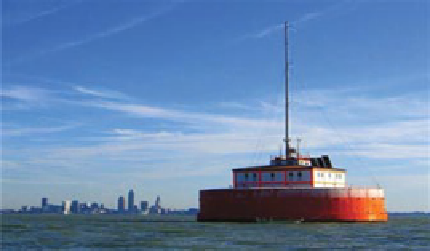Environmental Engineering Reference
In-Depth Information
(a)
(b)
Figure 14-10.
(a) Monitoring tower installed on the top of the Cleveland Crib facility.
Source:
EcoWatch, Ohio. (b) Ambrose Light C-MAN station outfitted with a suite of wind
resource assessment equipment.
Source:
AWS Truepower.
One example of where this approach has been undertaken is the Cleveland Crib,
which houses the main municipal water supply intake for the city of Cleveland, Ohio,
USA, on the shore of Lake Erie (Fig. 14-10a). A 30-m monopole tower, equipped
with three levels of instrumentation, was installed on the top of the structure in 2005
to support the development of an offshore wind farm. More recently, the facility has
also hosted a lidar unit.
Another example is the Ambrose Light C-MAN station off the coast of Long Island,
New York, USA (Fig. 14-10b). Owned and maintained by the US National Data Buoy
Center, this C-MAN station was outfitted with anemometers and a sodar system to
help characterize the offshore wind environment in the Atlantic Ocean off the coasts
of the states of New York and New Jersey.
Often, an important challenge of using an existing structure is that it may influence
the wind measurements. Large structures such as lighthouses, oil-drilling platforms,
and the like cause substantial flow distortions all around them, either reducing or
increasing the observed speeds depending on their shape, the wind direction, and
the placement of the wind measurement system. These distortions can sometimes be
estimated and partially removed through CFD modeling, but nevertheless, the accuracy
of the corrected measurements usually suffers.
14.2.4 Weather Buoys
Weather buoys can be useful for offshore resource assessment in several ways. First,
they can be deployed early in the development process, with fewer permitting hur-
dles than fixed platforms, and thus can support preliminary site assessments and
help establish a longer baseline of surface meteorological and ocean measurements.
1
Later, if a fixed platform is deployed, the measurements from both buoy and platform
can be integrated into a more complete assessment of the ocean-wind environment.
1
It should be noted that in environments subject to severe icing, weather buoys might have to be retrieved
during the winter. The resulting gaps in the data stream could offset some of their advantages.













Search WWH ::

Custom Search